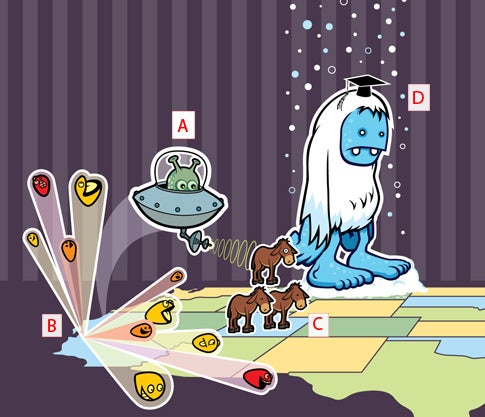A Geek’s Guide to Colleges
Where to go if you want to clone mules, hunt aliens, or just build a better videogame

A. Find “Them”
**University of California at Berkeley
Where: Berkeley, Calif.
Department: Search for Extraterrestrial Intelligence (SETI)
**
SETI@home taps the power of thousands of ordinary PCs over the Web to create, in effect, one of the most powerful supercomputers anywhere. It analyzes data from radio telescopes looking for signals from intelligent life. Berkeley students help improve the search algorithms and refine the software that ties all the computers together.
B. Shoot Particles
**Stanford University
Where: Palo Alto, Calif.
Department: Stanford Linear Accelerator Center
**
Every summer, undergrads join Nobel Prize–winning scientists here to send electrons down the longest linear accelerator in the world at close to 670 million mph, producing superpowerful x-rays. One of the latest projects uses the x-ray beam to create 3-D images of individual molecules.
slac.stanford.edu
C. Clone Life
**Utah State University
Where: Logan, Utah
Department: Center for Integrated BioSystems
**
In 2003, scientists at Utah State were the first in the world to clone a hybrid animal—a mule, the typically sterile offspring of a donkey and a horse. The research ultimately spawned commercial equine-cloning labs. Now students and faculty churn out up to 600 cloned embryos a week, primarily for genetics research.
biosystems.usu.edu
D. Enter The Deep Freeze
**Montana State University
Where: Bozeman, Mont.
Department: Subzero Science and Engineering Laboratory
**
This fall, students will step into a –80°F laboratory to study stuff in deep freeze. One project will look for life in 250,000-year-old ice cores taken from two miles underneath the Antarctic. Others will study the best way to keep winter roads ice-free, and research the flow of snow to better predict avalanches.
www.coe.montana.edu

A Geek’s Guide to East Coast Colleges
E. Hang with Monkeys
**University of Wisconsin
Where: Madison, Wis.
Department: Wisconsin National Primate Research Center
**
UWM’s primate-research center—home to 1,300 rhesus monkeys—has logged both biomedical and behavioral breakthroughs in fields such as socialization and aging, as well as HIV and Parkinson’s disease. Students aid stem-cell scientists in research on human and monkey embryonic cells.
primate.wisc.edu
F. Build Robots
**Carnegie Mellon University
Where: Pittsburgh, Pa.
Department: Robotics Institute
**
Carnegie Mellon is robot Mecca, home to ‘bot builders for 29 years. The first university to award a robotics Ph.D., it now offers a minor for undergrads, who put together water-striding mini robots or turn wrenches on autonomous SUVs for the Darpa Urban Challenge, where CMU took first place last year.
www.ri.cmu.edu
G. Create Videogames
**Cornell University
Where: Ithaca, N.Y.
Department: Game Design Initiative
**
At the first Ivy League school to offer a minor in game design, students take classes like “Foundations of Artificial Intelligence” and “Computer Animation.” The final project: building their own game. (The school’s design software keeps code-writing to a minimum.) Alumni have worked on blockbusters like The Sims and Spore.
gdiac.cis.cornell.edu
H. Float Around Weightless
**University of Maryland
Where: College Park, Md.
Department: Space Systems Laboratory
**
Don a space suit and climb into a neutral buoyancy tank to conduct low- and zero-gravity tests on next-gen astronaut gear, as well as space- and deep-sea-bound robots. Maryland’s 50-foot-diameter, 367,000-gallon tank is one of only two in the U.S., and the only one at a university.
ssl.umd.edu
I. Study Killer Bugs
**Boston University
Where: Boston, Mass.
Department: Emerging Infectious Diseases Laboratory
**
BU’s new biosafety-level-4 facility, opening this year, will be one of only a handful of labs where researchers can study contagious killers like smallpox and Ebola. Undergrads won’t log time in the full-body suits, but they will conduct pathogen research in state-of-the-art labs and learn from top infectious-disease scientists.
bu.edu/dbin/neidl/en
J. Run The Widest Screen
**New York University
Where:New York, N.Y.
Department: Interactive Tele-communications Program
**
Students here design interactive video for a 120-foot, high-resolution screen inside architect Frank Gehry’s InterActiveCorp building in New York, typically used to display art and advertising. One student project used animations of bees flocking to flowers to visualize complex stock market data.
itp.nyu.edu